Out of the box thinking about the Florida Market
 "Coach Toby sings his message to the skies about the importance of good nutrition and exercise. Junkfood Janey, played by Erika Johnson, is amazed to learn that too much sugar may produce a burst of energy but it will inevitably let you down. PETER TABER. From "Entertainment is hook for children’s nutrition education program." (What is to prevent us from doing this, but having the programs at the market, for parents and children? And this is done by some health organizations at farmers markets, including Kaiser Permanente "Family Days" at various FreshFARM Markets in DC.)
"Coach Toby sings his message to the skies about the importance of good nutrition and exercise. Junkfood Janey, played by Erika Johnson, is amazed to learn that too much sugar may produce a burst of energy but it will inevitably let you down. PETER TABER. From "Entertainment is hook for children’s nutrition education program." (What is to prevent us from doing this, but having the programs at the market, for parents and children? And this is done by some health organizations at farmers markets, including Kaiser Permanente "Family Days" at various FreshFARM Markets in DC.)-----------------------------
Also see this blog entry: Florida Market destruction legislation hearing, Weds. October 11th
-----------------------------
One of the biggest "problems" with the Florida Market is what Kevin Lynch called legibility. For more on the concept, here's a brief paper, "Legibility: Helping People Find There Way Around."
This is complicated, because the Market has two very different roles. It is a wholesale food distribution center that supports business clients. And it sells retail. But the majority of the commerce conducted there is wholesale. The place isn't set up for a lot of retail business.
This has consequences. There aren't many places to go to the restroom. There aren't good places to buy a cup of coffee and linger. "Merchandising," making great looking displays, etc., is practically a foreign concept. There are language and communications issues. There are hours issues--most of the businesses are focused on business clients, so that hours aren't necessarily conducive to retail, etc.
For example, for most food businesses Saturday is the biggest sales day of the week--but Litteri's closes at 3 pm. And except for the "cinder block" market, the Farmers Market building, all the businesses are closed on Sundays, which is the second biggest sales day for food-related retail businesses.
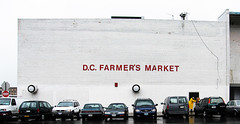 Flickr photo by EZRaw.
Flickr photo by EZRaw.The reason Elise Bernard of Frozen Tropics and I often mention the Italian Market in Philadelphia is that it is a perfect model, mixing hip retail places like Fantes as well as coffee shops and cafes, as well as the wholesale food aspect of the business, and grit as well.
Speaking of grit, I was blown away at the tour that Elise and I did in July, because there were two or three babies in attendance--with strollers. Yet this is how I often think of the market area--not a place for babies.
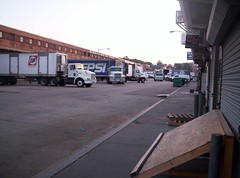
Speaking of Fantes, tomorrow their in-store cooking demonstration is:
How to Make Ricotta at Home; Saturday, Sept 30th; 11 am to 2 pm.
One thing that we do a very very very very very very bad job of in DC, and in most cities I suspect, is approaching every revitalization opportunity intending to accomplish multiple objectives.
I think as a hangover of the concept of separating uses in zoning regulations and the comprehensive-rational planning model more generally, we haven't really embraced the idea of what Jane Jacobs calls "mixed primary uses."
This should be thought of in many dimensions. On a site, it means mixing commercial, residential, and retail. It can be within a single building--vertical mixed use, which is often preferred in the city--or on a site, horizontal mixed-use (which still creates zones of single use and often vitality problems at the street level).
It should also reflect the idea of the historical mixing of uses in downtown and traditional commercial districts--public and private uses--public uses such as city hall and other government offices, post office, library, schools, as well as commercial, retail, and entertainment, plus residential, now within the downtown core-central business district, and in the old days, abutting this area.
As soon as the idea of revitalizing the Florida Market area was put forth by the Office of Planning two years ago--based on strengthening and extending the historic character and use of the market, not by tearing it down--I have been suggesting that another dimension could and should be added to the market, certain public functions.
For example, La Boqueria in Barcelona has a teaching room, and they teach kids how to cook and about nutrition. (Click here for the webpage which is in Catalan or Spanish.)
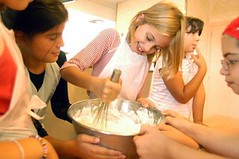
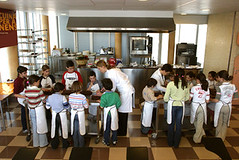
In DC, the Office on Aging teaches seniors, usually men, how to cook--often the cooking students were reliant on a partner for cooking, and for whatever reason their situation is now different. and they have to learn how to cook--but they are embarrassed. Everybody in the city would want to take cooking classes at a revitalized Florida Market!
Similarly USDA, WIC, and school education programs often provide nutrition education programs; so do health organizations.
I have suggested that such functions be added into the revitalization concept for the Florida Market, to expand the learning opportunities, and to do it in a way that reduces "social exclusion" factors. If the Florida Market is a kicking, fun place--and the prices are vastly better than Eastern Market, as much as I love Eastern Market--people who are there will be thought of as being there because it's a cool place, not because they are going to a food education class for "poor" people.
Similarly, this area can be used better to help foster the development of new businesses. Today's Examiner has an article about a food-related business in Alexandria, "Heather Stouffer: Local mom turns health-conscious lifestyle into baby food business."
Well, I have written before about the business incubator in Athens, Ohio that does the same thing, the Appalachian Center for Economic Networks. Such a facility could be located in the Florida Market area.
E.g., awhile back Firehook Bakery was looking to move their baking operations to DC. The Florida Market area would have been a perfect place to do so--if we could just get Gallaudet to give up their parking lots and construction materials storage lot space (talk about wasted space).
This is another example of mixed primary uses and in fact illustrates Jane Jacobs' point that a large stock of old buildings with cheap rents are necessary to stoke the development of new businesses and innovation. Richard Florida has milked the "Creative Class" concept for all that it's worth, but Jane Jacobs provided the foundational ideas 45 years ago!
Fred Kent of Project for Public Spaces has retermed this concept "Layering," see "Pride of Place: Fred Kent and the Project for Public Spaces," from Governing Magazine.
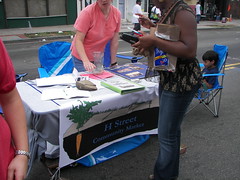 H Street Community Market booth at the H Street Festival.
H Street Community Market booth at the H Street Festival.One more thing, almost since the H Street Community Market concept has been suggested, I say, open in the Florida Market area. For one, it would add an education and organic option that isn't really provided currently. Etc.
This is a much different orientation than bringing out the bulldozers and wrecking balls.
 The demolition of the U.S. Beef building, 4th and Morse Streets NE.
The demolition of the U.S. Beef building, 4th and Morse Streets NE.The U.S. Beef building was recently demolished by the proposers of the "New Towns" plan. So much for asset-based revitalization.
Index Keywords: food-agriculture-markets; mixed-primary-uses; urban-design-placemaking



1 Comments:
To enjoy good health, to bring true happiness to one's family, to bring peace to all, one must first discipline and control one's own mind....
Post a Comment
<< Home